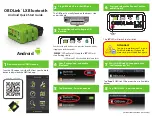
3 Operating the iVentTM201 – Setting Modes and Parameters
61
Figure 29: The Initial O.V.T Pop-Up Window
3.
Follow the instructions on the screen. Use the plastic caps to seal off the
following:
The patient Wye sensor, and
The exhalation valve
4.
Press the knob to begin the test. A pop-up window appears which indicates
the test has begun.
5.
After several seconds, another pop-up window appears and instructs you to
remove the cap on the exhalation valve leaving the cap on the Wye
outlet.
6.
After the ventilator performs further testing, it sounds an alarm. If you can
hear the alarm, press the Control Knob to complete the O.V.T. If remote
alarm is connected verify the alarm is activated in remote station.
Once the iVent
TM
201 has successfully completed the O.V.T., the patient circuit and
ventilator are ready for use.
If the O.V.T. fails:
1.
Verify that both Flow Sensor tubes are properly and snugly connected to the
correct luer ports on the front of the iVent
TM
201. (Note: Remember that two
lines go to the patient Wye connectors, and the blue line goes to the
Expiratory Valve Control connector.) Repeat the test.
2.
If the O.V.T. fails once again, then replace the patient circuit.
3.
If after replacing the patient circuit, the O.V.T. still fails, try re-calibrating the
ventilator. If calibration fails to correct the O.V.T. failure, immediately remove
the ventilator from service and contact a Versamed approved technician.
STANDBY AND PATIENT VENTILATION
When you have selected the weight, the iVent
TM
201 enters
Standby
, ready to
ventilate the patient with a press of the Control Knob. By default iVent
TM
201
starts up in SIMV Volume control.
To start ventilation from Standby mode:
Summary of Contents for iVent 201 1.4
Page 1: ...GE Healthcare iVentTM201 User s Reference Manual Revision 13 ...
Page 2: ...VersaMed a General Electric Company doing business as GE Healthcare ...
Page 4: ......
Page 14: ......
Page 42: ......
Page 68: ...56 Notes ...
Page 70: ......
Page 98: ...86 Notes ...
Page 100: ......
Page 140: ...128 Notes ...
Page 142: ......
Page 152: ......
Page 154: ......
Page 184: ......
Page 201: ...7 Care Maintenance and Tests 189 Notes ...
Page 202: ......
Page 203: ...Appendix A Glossary 191 APPENDIX A GLOSSARY ...
Page 204: ......
Page 210: ...198 Notes ...
Page 211: ...Appendix B Warranty 199 APPENDIX B WARRANTY ...
Page 212: ......
Page 215: ...Appendix C Operating Theory 203 APPENDIX C OPERATING THEORY ...
Page 216: ......
Page 219: ...Appendix C Operating Theory 207 ...
Page 220: ......
Page 221: ...Appendix C Operating Theory 209 Notes ...
Page 222: ......
Page 223: ...Appendix D Theory of Breath Delivery 211 APPENDIX D THEORY OF BREATH DELIVERY ...
Page 224: ......
Page 233: ...Appendix D Theory of Breath Delivery 221 Notes ...
Page 234: ......
Page 235: ...Appendix E Ventilation Modes 223 APPENDIX E VENTILATION MODES ...
Page 236: ......
Page 243: ...Appendix E Ventilation Modes 231 Notes ...
Page 244: ......
Page 246: ......
Page 252: ...240 Notes ...
Page 253: ...Appendix G Accessories 241 APPENDIX G ACCESSORIES ...
Page 254: ......
Page 277: ...Appendix H Remote Alarm Connector 265 APPENDIX H REMOTE ALARM CONNECTOR ...
Page 278: ......
Page 280: ......
Page 281: ...Appendix I Part Numbers and Accessories 269 APPENDIX I PART NUMBERS AND ACCESSORIES ...
Page 282: ......
Page 286: ...274 ...
Page 289: ...Index 277 ...















































